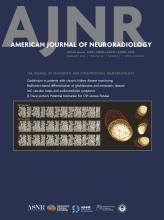This article requires a subscription to view the full text. If you have a subscription you may use the login form below to view the article. Access to this article can also be purchased.
Abstract
BACKGROUND AND PURPOSE: Even though glioblastoma (GB) and brain metastases (BM) can be differentiated using radiomics, it remains unclear if the model performance may vary based on the contrast-enhanced sequence used. Our aim was to evaluate the radiomics-based model performance for differentiation between GB and brain metastases BM using MPRAGE and volumetric interpolated breath-hold examination (VIBE) T1-contrast-enhanced sequence.
MATERIALS AND METHODS: T1 contrast-enhanced (T1-CE) MPRAGE and VIBE sequences acquired in 108 patients (31 GBs and 77 BM) during the same MRI session were retrospectively evaluated. After standardized image preprocessing and segmentation, radiomics features were extracted from necrotic and enhancing tumor components. Pearson correlation analysis of radiomics features from tumor subcomponents was also performed. A total of 90 machine learning pipelines were evaluated using a 5-fold cross-validation. Performance was measured by mean area under the curve (AUC)-receiver operating characteristic (ROC), log loss, and Brier scores.
RESULTS: A feature-wise comparison showed that the radiomics features between sequences were strongly correlated, with the highest correlation for shape-based features. The mean AUC across the top 10 pipelines ranged between 0.851 and 0.890 with T1-CE MPRAGE and between 0.869 and 0.907 with the T1-CE VIBE sequence. The top-performing models for the MPRAGE sequence commonly used support vector machines, while those for the VIBE sequence used either support vector machines or random forest. Common feature-reduction methods for top-performing models included linear combination filter and least absolute shrinkage and selection operator for both sequences. For the same machine learning feature-reduction pipeline, model performances were comparable (AUC-ROC difference range, –0.078–0.046).
CONCLUSIONS: Radiomics features derived from T1-CE MPRAGE and VIBE sequences are strongly correlated and may have similar overall classification performance for differentiating GB from BM.
ABBREVIATIONS:
- AUC
- area under the curve
- BM
- brain metastases
- GB
- glioblastoma
- LASSO
- least absolute shrinkage and selection operator
- linComb
- linear combinations filter
- ML
- machine learning
- MRMR
- minimum-redundancy maximum-relevance
- NIfTI
- Neuroimaging Informatics Technology Initiative
- RF
- random forest
- ROC
- receiver operating characteristic curve
- SUSAN
- Smallest Univalue Segment Assimilating Nucleus
- SVM
- support vector machine
- T1-CE
- T1 contrast-enhanced sequence
- VIBE
- volumetric interpolated breath-hold examination
- © 2025 by American Journal of Neuroradiology












